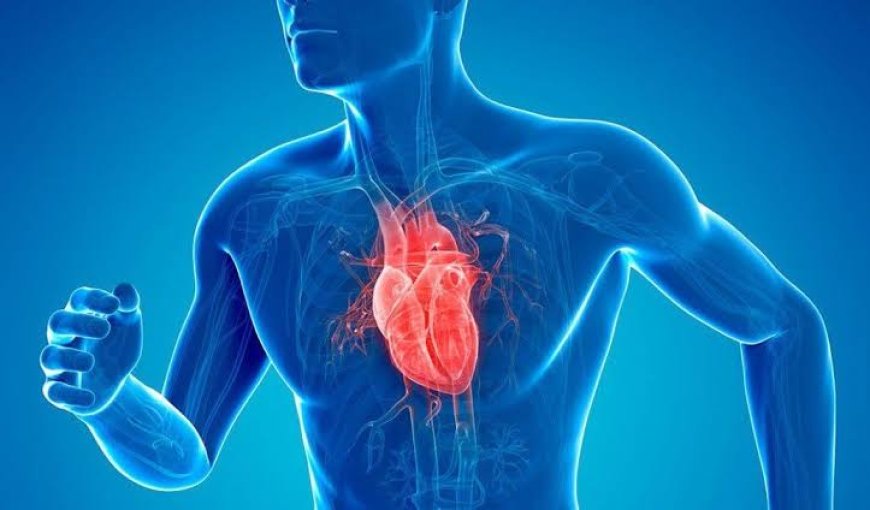Just what It takes to maintain a healthy heart

Friday, 18 October, 2024
McCreadie Andias
A recent report by the WHO indicates that Cardiovascular diseases (CVDs) are the world’s leading killer, causing 1 in every 3 deaths.
The cause of heart attacks and strokes are usually the presence of a combination of risk factors, such as tobacco use, unhealthy diet and obesity, physical inactivity and use of alcohol, hypertension, diabetes and high level of cholesterol.
It is never too late to start changing your lifestyle towards a healthier heart, by the look of these worrying statistics you can just see how important it is to take care of your heart.
Here are some of the lethal heart problems in the world today
1. Coronary Artery Disease (CAD)
CAD occurs when the coronary arteries, which supply oxygen-rich blood to the heart muscle, are narrowed or blocked due to the buildup of atherosclerotic plaques (composed of fat, cholesterol, and other substances). Risk factors include high LDL cholesterol, smoking, high blood pressure, diabetes, and a sedentary lifestyle.
Lifestyle modifications such as maintaining a healthy diet (low in saturated fats and cholesterol), regular physical activity, quitting smoking, managing blood pressure and cholesterol, and controlling diabetes can be very helpful to reduce risks of this disease.
2. Heart Attack (Myocardial Infarction)
A heart attack occurs when a coronary artery is completely blocked, often by a blood clot, preventing oxygenated blood from reaching a part of the heart muscle. The most common cause is atherosclerosis leading to plaque rupture.
3. Heart Failure
Heart failure occurs when the heart is unable to pump blood efficiently, leading to fluid buildup in the lungs and other tissues. Causes include coronary artery disease, heart attacks, high blood pressure, and cardiomyopathy (heart muscle disease).
4. Arrhythmias
Arrhythmias are abnormal heart rhythms caused by disruptions in the heart’s electrical signaling. These may result from coronary artery disease, heart failure, electrolyte imbalances, or congenital defects. Common types include atrial fibrillation (AFib), ventricular tachycardia, and bradycardia.
5. Hypertensive Heart Disease
Long-standing high blood pressure (hypertension) forces the heart to work harder, leading to thickening of the heart muscle (left ventricular hypertrophy) or heart failure. Over time, the heart's ability to pump blood efficiently declines.
The disease can be prevented by Controlling blood pressure through dietary changes (reducing salt intake), regular exercise, and medications can prevent hypertensive heart disease. Managing stress and avoiding smoking and alcohol are also important.
6. Valvular Heart Disease
Valvular heart disease occurs when one or more of the heart's valves do not function properly due to stenosis (narrowing) or regurgitation (leakage). Causes include congenital defects, aging (calcification of the valves), rheumatic fever, and infections like infective endocarditis.
7. Cardiomyopathy
Cardiomyopathy is a disease of the heart muscle that can be genetic or acquired. It includes dilated cardiomyopathy (enlarged heart chambers), hypertrophic cardiomyopathy (thickened heart walls), and restrictive cardiomyopathy (rigid heart walls). Causes include viral infections, alcohol abuse, autoimmune diseases, and genetic mutations.
8. Congenital Heart Disease
Congenital heart disease includes structural defects of the heart present at birth. These can range from small holes in the heart (septal defects) to complex malformations like tetralogy of Fallot. Causes are often genetic but may also be influenced by maternal factors (e.g., infections, drug use during pregnancy).
9. Pericarditis
Pericarditis is inflammation of the pericardium, the sac surrounding the heart. Causes include viral infections, autoimmune disorders, kidney failure, and chest trauma. It often presents with sharp chest pain that worsens when lying down.
10. Endocarditis
Endocarditis is an infection of the heart valves or inner lining (endocardium), usually caused by bacteria entering the bloodstream and attaching to damaged heart valves. Common risk factors include poor dental hygiene, intravenous drug use, and pre-existing valve defects.
Heart diseases are multifactorial and can arise from genetic predispositions, lifestyle factors, infections, or structural defects.Therefore, Prevention is key in many cases, with lifestyle changes, medication management, and regular medical checkups playing a crucial role.
Treatment varies from medications to surgical interventions depending on the condition and its severity. Early detection and management are also vital for improving outcomes in heart disease.
Meanwhile, Maintaining a healthy heart involves a combination of lifestyle choices and activities that improve cardiovascular health. Here are 10 key activities and how they work to keep the heart strong and reduce the risk of heart disease:
1. Regular Aerobic Exercise
Aerobic exercise, such as walking, running, cycling, and swimming, strengthens the heart muscle, improves blood circulation, and enhances oxygen utilization by tissues. It increases heart rate and improves the efficiency of the cardiovascular system. Over time, it helps lower resting heart rate and blood pressure, which reduces the heart's workload.
2. Strength Training
Strength training (resistance exercises) helps build muscle mass, which improves overall body metabolism and enhances insulin sensitivity. It reduces fat levels and helps maintain a healthy weight, thus reducing strain on the heart. Strength training also promotes arterial flexibility, which improves blood flow.
Activities such as Weightlifting, using resistance bands, or bodyweight exercises like push-ups and squats are helpful strength training techniques.
3. Eating a Heart-Healthy Diet
A diet rich in fruits, vegetables, whole grains, lean proteins, and healthy fats (such as those from fish and nuts) supports heart health by reducing cholesterol levels, lowering blood pressure, and preventing atherosclerosis (plaque buildup in arteries). Foods high in antioxidants, fiber, and healthy fats can protect against inflammation and improve blood vessel function.
The Mediterranean diet, rich in olive oil, fish, whole grains, and fruits, or the DASH (Dietary Approaches to Stop Hypertension) diet, focuses on reducing sodium and increasing nutrient-rich foods.
4. Maintaining a Healthy Weight
Excess body fat, especially around the abdomen, increases the risk of developing heart disease because it raises blood pressure, cholesterol, and blood sugar levels. By maintaining a healthy weight, you reduce strain on the heart, lower the risk of hypertension and diabetes, and prevent metabolic disorders.
Regular exercise combined with a balanced diet helps control body weight and prevent obesity, is a significant risk factor for heart disease.
5. Managing Stress
Chronic stress triggers the release of stress hormones like cortisol and adrenaline, which can increase heart rate and blood pressure. Over time, this contributes to inflammation and can damage arteries.
Stress management techniques lower these hormones, promote relaxation, and improve heart rate variability, reducing the risk of cardiovascular events.
Practices like meditation, deep breathing exercises, yoga, mindfulness, or even engaging in hobbies help manage stress.
6. Getting Enough Sleep
Sleep plays a critical role in heart health. During sleep, the heart rate and blood pressure drop, giving the heart time to rest and recover. Poor sleep quality or insufficient sleep can lead to increased blood pressure, inflammation, and a higher risk of heart disease.
Aim for 7-9 hours of quality sleep per night, maintain a regular sleep schedule, and create a calming bedtime routine.
7. Quitting Smoking
Smoking damages the blood vessels, increases blood pressure, and reduces the amount of oxygen that the blood can carry, making the heart work harder.
Smoking also accelerates the buildup of plaque in arteries, increasing the risk of coronary artery disease and heart attacks. Quitting smoking can reverse some of the damage and reduce the risk of heart disease significantly within a few years.
Use nicotine replacement therapies, counseling, or medications to assist with quitting smoking.
8. Limiting Alcohol Consumption
Excessive alcohol consumption can lead to high blood pressure, heart failure, and irregular heartbeats. It also contributes to weight gain and raises triglyceride levels, which increase the risk of heart disease. Moderate alcohol intake, on the other hand, may offer some cardiovascular benefits by increasing HDL (good) cholesterol levels, but overconsumption negates these benefits.
Limiting alcohol to one drink per day for women and two drinks per day for men (if you drink alcohol at all) is recommended.
9. Staying Hydrated
Proper hydration helps maintain optimal blood volume and consistency, which is crucial for proper heart function. Dehydration can lead to thicker blood, making it harder for the heart to pump blood efficiently, leading to increased heart rate and blood pressure. Staying hydrated ensures smooth blood flow and helps in regulating body temperature.
Drinking sufficient water throughout the day (roughly 8-10 glasses) or hydrating based on physical activity level and environment will help balance your water levels.
10. Maintaining Regular Health Checkups
Regular medical checkups allow for early detection and management of heart disease risk factors such as high blood pressure, high cholesterol, and diabetes. Managing these conditions with medication, lifestyle changes, or other treatments helps prevent heart disease progression.
Regular monitoring helps keep the heart functioning optimally.Annual checkups with a healthcare provider helps to monitor blood pressure, cholesterol, and glucose levels, and to assess heart function through tests like EKG or echocardiograms.
Bottom line
There are many changes you can make to help keep your heart healthy and strong. Improving your diet, engaging in physical activity, and taking care of your mental health can all help with heart health.
If you aren’t sure where to begin, speak with a medical professional about your concerns, and they can help create a treatment plan that works for your needs and lifestyle.
What's Your Reaction?
































































































































































































































































































